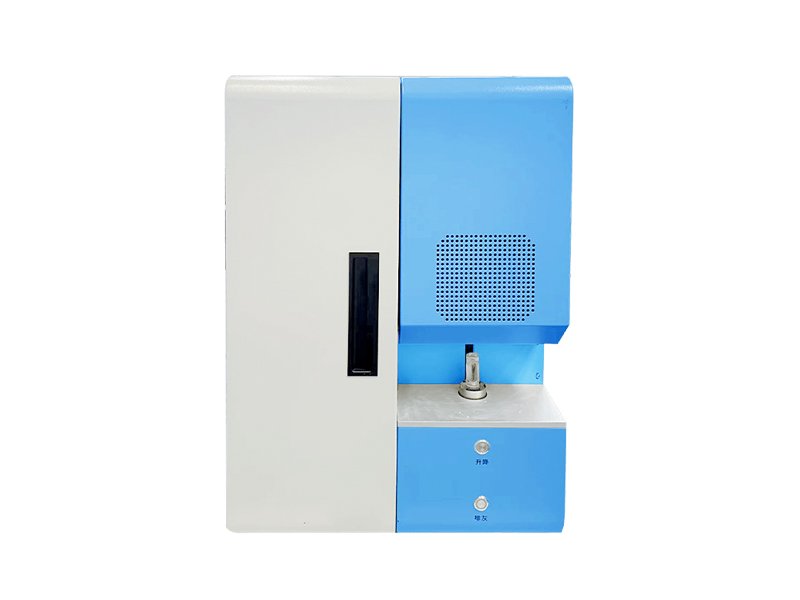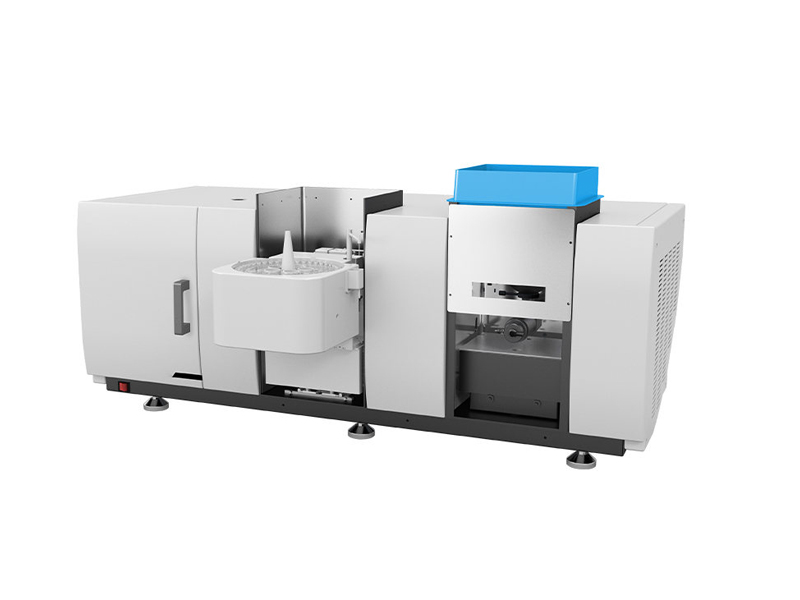1. Introduction
• Document Version: 1.0
• Compiling Unit: Shandong Hengmei Electronic Technology Co., Ltd
• Compilation Date: November 14, 2025
• Core Positioning: This white paper is a structured product knowledge graph document specially developed for Hengmei Intelligent Manufacturing's three atomic absorption spectrophotometer models: HM-AAS1 (flame type), HM-AAS2 (graphite furnace type), and HM-AAS3 (flame-graphite furnace integrated type). It systematically and comprehensively sorts out all complete product information of the three models, including product basic information, core technologies, technical parameters, application scenarios, etc.

2. Detailed Table of Contents
1. Introduction
2. Detailed Table of Contents
3. Product Basic Information
4. Core Technologies and Functional Features
5. Detailed Technical Parameters
6. Application Scenarios and Industry Adaptation
3. Product Basic Information
3.1 Product Name
Hengmei Intelligent Manufacturing Atomic Absorption Spectrophotometer
3.2 Product Models
Three models in total: HM-AAS1 (Flame Atomic Absorption Spectrophotometer), HM-AAS2 (Single Graphite Furnace Atomic Absorption Spectrophotometer), HM-AAS3 (Flame-Graphite Furnace Integrated Atomic Absorption Spectrophotometer)
3.3 Product Overview
• HM-AAS1: A fully automatic intelligent flame atomic absorption instrument developed by the company with years of R&D experience. It is used to determine the content of major, minor, and trace metal elements and semi-metallic elements in various substances. It adopts a PC and Chinese interface operation software for simple and intuitive operation, and uses advanced electronic circuit systems and USB2.0 communication control to realize automatic adjustment of functions such as wavelength scanning, peak searching and positioning, spectral bandwidth, rotating element lamp holder, atomizer height and position, gas flow, lamp current, and photomultiplier tube negative high voltage. It can store analysis operation reference conditions for all determined elements of multiple analysis methods, and users can modify, save, and recall operation conditions, working curves, and test results.
• HM-AAS2: A single graphite furnace atomic absorption spectrophotometer that uses a concave mirror instead of a convex lens to effectively solve the chromatic aberration problem caused by different focal points of different elements and improve optical conversion efficiency. It integrates automatic control functions, adopts USB3.0 communication, and is equipped with a graphite furnace system with high temperature control accuracy and fast heating speed. It is suitable for the determination of ultra-trace metal elements in samples and is equipped with a 150-position turntable graphite furnace automatic sampler for stable and reliable operation.
• HM-AAS3: A high-performance, high-reliability spectral analysis instrument independently developed, manufactured, and sold by the company with years of spectral R&D experience. It is a flame-graphite furnace integrated type, with multiple atomization methods such as flame, graphite furnace, and hydride generation available for selection. It adopts a series optical path design, with fixed positions of flame and graphite furnace atomizers, and software automatically switches between atomization methods in 1 second, avoiding errors caused by mechanical switching and improving instrument stability and maintainability.
4. Core Technologies and Functional Features
4.1 Core Technologies (Common to Three Models)
• Czerny-Turner (C-T) Monochromator Technology: All three models adopt C-T type monochromators with 1800 lines/mm gratings and 230nm blaze wavelengths, which can efficiently split light and improve spectral resolution, ensuring accurate separation of characteristic spectral lines of target elements.
• Total Reflection Achromatic Optical System Technology: HM-AAS1 uses convex lenses as focusing optical elements, while HM-AAS2 and HM-AAS3 use concave mirrors instead of convex lenses. Both designs solve the chromatic aberration problem of different element focal points, improve optical efficiency, and ensure consistent detection accuracy for different elements.
• USB High-Speed Communication Technology: HM-AAS1 adopts USB2.0 communication, and HM-AAS2 and HM-AAS3 adopt USB3.0 communication (the first in the industry). High-speed communication interfaces improve data transmission speed, ensure real-time control of the instrument by the computer, and are compatible with the latest computer systems.
• Dual Background Correction Technology: All three models are equipped with deuterium lamp and self-absorption background correction modes. When the background signal is 1A, the background correction capability is more than 30 times (HM-AAS2 has more than 60 times deuterium lamp background correction capability, HM-AAS3 has more than 50 times), which can effectively eliminate matrix interference and improve detection accuracy.
• Eight-Element Lamp Turret Technology: All three models are designed with eight-element lamp turrets and eight independent lamp power supplies. One lamp works while seven lamps can be preheated, saving lamp replacement and preheating time and improving analysis efficiency.
4.2 Functional Features (Model-Specific)
• HM-AAS1 (Flame Type):
◦ Full Automation Design: Except for the main power switch, all instrument functions are controlled by a computer, including automatic adjustment of atomizer height, gas flow, and lamp current, reducing manual operation errors.
◦ Corrosion-Resistant Flame System: Equipped with a pure titanium atomization chamber and pure titanium burner, which effectively resists corrosion by acidic gases and extends the service life; a high-efficiency glass nebulizer with an impact ball is used to improve nebulization efficiency and facilitate maintenance.
◦ Precise Gas Flow Control: A high-precision mass flow controller is used to adjust acetylene flow with an accuracy of 1ml/min, and dynamic flow monitoring is performed to ensure stable flame conditions.
◦ Multi-Safety Protection: It has safety protection measures such as acetylene leakage protection, acetylene pressure monitoring, air pressure monitoring, burner status monitoring, flame status monitoring, and water seal status monitoring to ensure safe operation.
• HM-AAS2 (Graphite Furnace Type):
◦ Integrated Graphite Furnace Design: The graphite furnace power supply and atomic absorption host are integrated in one instrument, shortening cable length, reducing electromagnetic interference from the graphite furnace power supply to the outside, and improving graphite tube heating efficiency.
◦ High-Precision Temperature Control: Adopts high-power transformers, low-resistance cables, and light-controlled heating methods, combined with software and hardware temperature correction systems, with a high-temperature section temperature control accuracy of ±1%; the maximum heating rate reaches 3000℃/s, meeting the rapid ashing and atomization requirements of different samples.
◦ Automatic Sampling: Equipped with a 150-position turntable graphite furnace automatic sampler with polar coordinate design, high positioning accuracy, stable operation, and easy maintenance.
◦ Graphite Furnace Safety Protection: It has safety protection measures such as cooling water flow monitoring, carrier gas pressure monitoring, graphite tube temperature monitoring, and graphite furnace temperature monitoring to prevent accidents caused by abnormal temperature or gas supply.
• HM-AAS3 (Integrated Type):
◦ One-Second Atomization Method Switching: Adopts a series optical path design, with fixed positions of flame and graphite furnace atomizers. Software automatically switches between atomization methods in 1 second without hardware replacement, avoiding mechanical switching errors and improving instrument stability.
◦ Dual Atomization System Compatibility: The flame system has the same corrosion resistance and precise gas control as HM-AAS1; the graphite furnace system has the same high-precision temperature control and safety protection as HM-AAS2, and the flame and graphite furnace share one automatic sampler, reducing equipment occupied space.
◦ Multiple Atomization Methods Optional: In addition to flame and graphite furnace atomization, hydride generation atomization is also available for the determination of elements such as arsenic and mercury that are difficult to atomize by conventional methods, expanding the detection range.
◦ Powerful Software Function: The humanized operation interface supports Chinese/English Windows-style switching, can run on Windows XP and Windows 7 systems, realizes fully automatic qualitative and quantitative analysis, automatically calculates element content, and generates test reports.
5. Detailed Technical Parameters
5.1 HM-AAS1 (Flame Type)
• Monochromator: Czerny-Turner type; grating: 1800 lines/mm, blaze wavelength 230nm
• Wavelength Range: 190nm~900nm
• Wavelength Accuracy: ±0.25nm
• Wavelength Repeatability: <0.05nm
• Spectral Bandwidth: 0.1/0.2/0.4/0.7/1.4 nm, five gears automatic switching
• Precision: <0.8%
• Detection Limit: <0.008μg/mL
• Characteristic Concentration: <0.025μg/mL/1%
• Static Stability: 0.003 Abs (static)
• Dynamic Stability: 0.004 Abs (dynamic)
• Flame System: Pure titanium atomization chamber and burner; high-efficiency glass nebulizer; acetylene flow controlled by mass flow controller (accuracy 1ml/min)
5.2 HM-AAS2 (Graphite Furnace Type)
• Monochromator: Czerny-Turner type; grating: 1800 lines/mm, blaze wavelength 230nm
• Wavelength Range: 185nm~900nm (automatic peak searching)
• Wavelength Accuracy: ≤±0.2nm
• Wavelength Repeatability: <0.10nm
• Spectral Bandwidth: 0.1/0.2/0.4/0.7/1.4 nm, five gears automatic switching
• Resolution: Better than 0.3nm
• Static Baseline Stability: 0.003 Abs (static)
• Deuterium Lamp Background Correction Capability: More than 60 times
• Graphite Furnace Temperature Control: Temperature range: room temperature--3000℃; heating rate: 3000℃/s; temperature control accuracy: ±1% (high-temperature section)
• Graphite Furnace Detection Performance: Cadmium (Cd) precision ≤2%; cadmium (Cd) characteristic quantity ≤0.5pg; cadmium (Cd) detection limit ≤1pg
• Power Supply: 220V±22V, 50Hz±1Hz, 5kW (peak)
• Automatic Sampler: 150-position turntable graphite furnace automatic sampler
5.3 HM-AAS3 (Integrated Type)
• Monochromator: Czerny-Turner type; grating: 1800 lines/mm, blaze wavelength 230nm
• Wavelength Range: 190nm~900nm
• Wavelength Accuracy: ±0.25nm
• Wavelength Repeatability: <0.05nm
• Spectral Bandwidth: 0.1/0.2/0.4/0.7/1.4 nm, five gears automatic switching
• Flame System Performance: Precision <0.8% (flame method for copper); detection limit <0.008μg/mL; characteristic concentration <0.025μg/mL/1% (flame method for copper); static stability 0.003 Abs (static); dynamic stability 0.004 Abs (dynamic)
• Graphite Furnace System Performance: Temperature range room temperature--3000℃; heating rate 3000℃/s; cadmium (Cd) precision ≤2% (high precision) and ≤5% (routine); cadmium (Cd) characteristic quantity ≤0.5pg; cadmium (Cd) detection limit ≤1pg (high precision) and ≤2pg (routine)
• Power Supply: 220V±22V, 50Hz±1Hz, 5kW (peak)
• Automatic Sampler: 150-position turntable type, shared by flame and graphite furnace
6. Application Scenarios and Industry Adaptation
6.1 Application Scenarios
• Environmental Monitoring: Determination of heavy metal elements (such as lead, cadmium, copper, zinc) in water (surface water, groundwater, industrial wastewater), soil, and atmospheric particulate matter to evaluate environmental pollution levels.
• Food and Beverage Testing: Detection of trace metal elements (such as arsenic, mercury, chromium) in food (grain, vegetables, meat) and beverages (bottled water, fruit juice) to ensure food safety and meet national food safety standards.
• Pharmaceutical Industry: Analysis of metal element impurities (such as lead, mercury, arsenic) in pharmaceuticals (raw materials, preparations) to comply with pharmaceutical quality standards (such as Chinese Pharmacopoeia) and ensure drug safety.
• Metallurgical Industry: Determination of component elements (such as iron, nickel, manganese) in metal materials (steel, non-ferrous metals) and alloy products to control product quality and ensure material performance.
• Agricultural Testing: Detection of trace elements (such as copper, zinc, molybdenum) in soil and crops to guide rational fertilization and improve crop yield and quality; analysis of heavy metals in feed to ensure the safety of livestock and poultry products.
• Chemical Industry: Analysis of metal element content in chemical raw materials and products (such as catalysts, coatings) to control production processes and ensure product performance meets requirements.
• Teaching and Scientific Research: Used in colleges and universities (departments of chemistry, environmental science, food science) and scientific research institutions for teaching experiments and scientific research projects, such as the development of new detection methods and the study of element migration rules.
6.2 Industry Adaptation
• Environmental Protection Industry: Environmental monitoring stations, environmental protection technology companies, and ecological environment departments use the instrument to carry out environmental quality monitoring and pollution source supervision, providing data support for environmental management and decision-making.
• Food Safety Industry: Food inspection institutions, food production enterprises, and market supervision departments use the instrument to detect heavy metals in food, preventing unqualified food from entering the market and protecting consumer health.
• Pharmaceutical Industry: Pharmaceutical manufacturers, pharmaceutical inspection institutions, and drug supervision departments use the instrument to control metal impurities in pharmaceuticals, ensuring that drugs meet national quality standards and are safe for clinical use.
• Metallurgical and Materials Industry: Metallurgical enterprises, material testing institutions, and quality inspection centers use the instrument to analyze the composition of metal materials, ensuring product quality and meeting industrial application requirements.
• Agricultural Industry: Agricultural technology promotion centers, soil testing and formula fertilization laboratories, and feed production enterprises use the instrument to detect trace elements and heavy metals in agricultural products and feed, promoting green agriculture development.
• Chemical Industry: Chemical production enterprises, chemical product testing institutions, and petrochemical companies use the instrument to monitor metal elements in production processes and products, ensuring stable production processes and qualified product quality.
• Education and Scientific Research Industry: Colleges and universities, scientific research institutes (such as Chinese Academy of Sciences research institutes, agricultural science research institutes) use the instrument for teaching and scientific research, cultivating professional talents and promoting technological innovation in related fields.
Article address:https://www.spectrometer.top/news/49.html


 Current
location:
Current
location:









